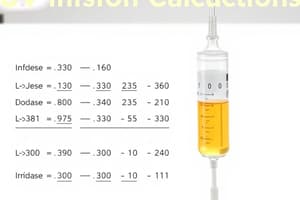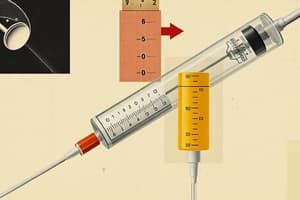Podcast
Questions and Answers
What is the recommended loading dose for this antiarrhythmic agent in cases of cardiac arrest?
What is the recommended loading dose for this antiarrhythmic agent in cases of cardiac arrest?
- 1 to 1.5 mg/kg (correct)
- 4 mg/kg
- 2 to 3 mg/kg
- 0.5 to 0.75 mg/kg
What is the maximum cumulative dose for this antiarrhythmic agent?
What is the maximum cumulative dose for this antiarrhythmic agent?
- 1 mg/kg
- 4 mg/kg
- 3 mg/kg (correct)
- 2 mg/kg
In the case of severe toxicity from this antiarrhythmic agent, what is the available antidote?
In the case of severe toxicity from this antiarrhythmic agent, what is the available antidote?
- Naloxone
- IV lipid emulsion (Intralipid®) (correct)
- Flumazenil
- Activated charcoal
What potential side effect should be monitored for during administration?
What potential side effect should be monitored for during administration?
Which of the following is a potential sign of CNS toxicity from this medication?
Which of the following is a potential sign of CNS toxicity from this medication?
What is the typical onset time for labetalol after intravenous administration?
What is the typical onset time for labetalol after intravenous administration?
What is a potential cause of bradycardia?
What is a potential cause of bradycardia?
What is the usual maximum cumulative IV dose of labetalol for severe hypertension?
What is the usual maximum cumulative IV dose of labetalol for severe hypertension?
In which situation should labetalol dosing be approached with caution?
In which situation should labetalol dosing be approached with caution?
Which medication is used for inotropic support?
Which medication is used for inotropic support?
What is the recommended concentration for Dobutamine reconstitution?
What is the recommended concentration for Dobutamine reconstitution?
Which of the following is a recommended practice for continuous IV infusion of labetalol?
Which of the following is a recommended practice for continuous IV infusion of labetalol?
What should be monitored before initiating Dobutamine if hypovolemia is present?
What should be monitored before initiating Dobutamine if hypovolemia is present?
What should be monitored regularly during the administration of labetalol?
What should be monitored regularly during the administration of labetalol?
What is the antidote available in case of Dobutamine extravasation?
What is the antidote available in case of Dobutamine extravasation?
What is the initial bolus dose of labetalol administered over 1-2 minutes for IV use?
What is the initial bolus dose of labetalol administered over 1-2 minutes for IV use?
What could a high-dose of labetalol potentially lead to?
What could a high-dose of labetalol potentially lead to?
What is the initial dosing range for Dobutamine infusion?
What is the initial dosing range for Dobutamine infusion?
What is a critical electrolyte disturbance to correct before using Dobutamine?
What is a critical electrolyte disturbance to correct before using Dobutamine?
What is the method of preparing a continuous infusion of labetalol?
What is the method of preparing a continuous infusion of labetalol?
What is the onset time for Dobutamine after administration?
What is the onset time for Dobutamine after administration?
What is the correct duration for the onset of immediate release PO diltiazem?
What is the correct duration for the onset of immediate release PO diltiazem?
What is the recommended frequency for monitoring blood pressure during a continuous IV infusion of diltiazem until hemodynamic stability is achieved?
What is the recommended frequency for monitoring blood pressure during a continuous IV infusion of diltiazem until hemodynamic stability is achieved?
What is the appropriate action regarding fluid removal from the D5W or NS bag before preparing the continuous IV infusion of diltiazem?
What is the appropriate action regarding fluid removal from the D5W or NS bag before preparing the continuous IV infusion of diltiazem?
What is the maximum dose rate specified for continuous diltiazem IV administration as directed by a physician?
What is the maximum dose rate specified for continuous diltiazem IV administration as directed by a physician?
Which of the following is NOT a sign to observe for during diltiazem administration?
Which of the following is NOT a sign to observe for during diltiazem administration?
What is the maximum infusion rate for magnesium sulfate unless there is an urgent indication?
What is the maximum infusion rate for magnesium sulfate unless there is an urgent indication?
Which of the following conditions is a contraindication for administering anxiety medication?
Which of the following conditions is a contraindication for administering anxiety medication?
What is the maximum allowable dose per hour for the administration of anxiety medication?
What is the maximum allowable dose per hour for the administration of anxiety medication?
What potential side effect is linked to the rapid administration of magnesium sulfate?
What potential side effect is linked to the rapid administration of magnesium sulfate?
What monitoring is recommended for direct IV administration of magnesium sulfate for ventricular arrhythmias?
What monitoring is recommended for direct IV administration of magnesium sulfate for ventricular arrhythmias?
What is a potential effect of benzodiazepine therapy that should be considered before administration?
What is a potential effect of benzodiazepine therapy that should be considered before administration?
How should the magnesium sulfate be administered for fluid-restricted patients?
How should the magnesium sulfate be administered for fluid-restricted patients?
What is the initial dose for continuous infusion of anxiety-reducing medication?
What is the initial dose for continuous infusion of anxiety-reducing medication?
What is the maximum dose for the continuous IV infusion of Isoproterenol?
What is the maximum dose for the continuous IV infusion of Isoproterenol?
What monitoring should be done every 5 minutes during the continuous IV infusion of Isoproterenol?
What monitoring should be done every 5 minutes during the continuous IV infusion of Isoproterenol?
Which of the following is NOT recommended in the initial treatment of Isoproterenol?
Which of the following is NOT recommended in the initial treatment of Isoproterenol?
When should the infusion site for Isoproterenol be monitored for extravasation?
When should the infusion site for Isoproterenol be monitored for extravasation?
What is the onset time for Isoproterenol administration?
What is the onset time for Isoproterenol administration?
What should be done if the patient has pre-existing ventricular arrhythmias?
What should be done if the patient has pre-existing ventricular arrhythmias?
Which parameter should be monitored as per physician discretion during Isoproterenol treatment?
Which parameter should be monitored as per physician discretion during Isoproterenol treatment?
What is the recommended volume for the loading dose of Isoproterenol?
What is the recommended volume for the loading dose of Isoproterenol?
Flashcards
Diltiazem Onset Time
Diltiazem Onset Time
Diltiazem's onset of action is roughly 3 minutes.
Diltiazem Bolus Dosage Time
Diltiazem Bolus Dosage Time
The bolus dose of diltiazem can be administered 1-3 hours beforehand.
Diltiazem Continuous Infusion Duration
Diltiazem Continuous Infusion Duration
A continuous diltiazem infusion can last from 30-60 minutes after the end of the infusion.
Continuous Diltiazem IV Infusion Dilution
Continuous Diltiazem IV Infusion Dilution
Signup and view all the flashcards
Monitoring during Diltiazem Infusion
Monitoring during Diltiazem Infusion
Signup and view all the flashcards
Dobut Amine: What's it for?
Dobut Amine: What's it for?
Signup and view all the flashcards
Dobut Amine: How is it given?
Dobut Amine: How is it given?
Signup and view all the flashcards
Preparing Dobut Amine: What are the common doses?
Preparing Dobut Amine: What are the common doses?
Signup and view all the flashcards
Dobut Amine: What are the risks?
Dobut Amine: What are the risks?
Signup and view all the flashcards
Dobut Amine: What are the monitoring parameters?
Dobut Amine: What are the monitoring parameters?
Signup and view all the flashcards
Dobut Amine: What if there's an overdose?
Dobut Amine: What if there's an overdose?
Signup and view all the flashcards
Dobut Amine: What are essential checks before using it?
Dobut Amine: What are essential checks before using it?
Signup and view all the flashcards
Dobut Amine: What else should be done before starting?
Dobut Amine: What else should be done before starting?
Signup and view all the flashcards
Isoproterenol Action
Isoproterenol Action
Signup and view all the flashcards
Isoproterenol Route
Isoproterenol Route
Signup and view all the flashcards
Isoproterenol Onset
Isoproterenol Onset
Signup and view all the flashcards
Isoproterenol Duration
Isoproterenol Duration
Signup and view all the flashcards
Why Isoproterenol Infusion?
Why Isoproterenol Infusion?
Signup and view all the flashcards
Isoproterenol Dosage Variations
Isoproterenol Dosage Variations
Signup and view all the flashcards
Isoproterenol Monitoring
Isoproterenol Monitoring
Signup and view all the flashcards
Contraindications for Isoproterenol
Contraindications for Isoproterenol
Signup and view all the flashcards
Lidocaine: Class?
Lidocaine: Class?
Signup and view all the flashcards
Lidocaine: Onset & Duration?
Lidocaine: Onset & Duration?
Signup and view all the flashcards
Lidocaine: How is it given?
Lidocaine: How is it given?
Signup and view all the flashcards
Lidocaine: What is the maximum dose?
Lidocaine: What is the maximum dose?
Signup and view all the flashcards
Lidocaine: What is the antidote for toxicity?
Lidocaine: What is the antidote for toxicity?
Signup and view all the flashcards
Labetalol Administration Routes
Labetalol Administration Routes
Signup and view all the flashcards
Labetalol IV Bolus Dosage
Labetalol IV Bolus Dosage
Signup and view all the flashcards
Labetalol IV Bolus Maximum Dose
Labetalol IV Bolus Maximum Dose
Signup and view all the flashcards
Labetalol IV Continuous Infusion Preparation
Labetalol IV Continuous Infusion Preparation
Signup and view all the flashcards
Labetalol IV Continuous Infusion Dose
Labetalol IV Continuous Infusion Dose
Signup and view all the flashcards
Labetalol Accumulation Risk
Labetalol Accumulation Risk
Signup and view all the flashcards
Labetalol Monitoring During IV Administration
Labetalol Monitoring During IV Administration
Signup and view all the flashcards
Labetalol Use in Hepatic Dysfunction
Labetalol Use in Hepatic Dysfunction
Signup and view all the flashcards
Magnesium Sulfate Infusion Rate
Magnesium Sulfate Infusion Rate
Signup and view all the flashcards
Magnesium Sulfate Dilution
Magnesium Sulfate Dilution
Signup and view all the flashcards
Magnesium Sulfate: When is it urgent?
Magnesium Sulfate: When is it urgent?
Signup and view all the flashcards
Monitoring Magnesium Sulfate
Monitoring Magnesium Sulfate
Signup and view all the flashcards
Flumazenil: What is it for?
Flumazenil: What is it for?
Signup and view all the flashcards
Benzodiazepine Infusion: What's the rate?
Benzodiazepine Infusion: What's the rate?
Signup and view all the flashcards
Benzodiazepine Overdose: Contraindications
Benzodiazepine Overdose: Contraindications
Signup and view all the flashcards
Study Notes
Emergency Department Intravenous Infusion Guidelines
- Initiation Time: Any infusion prepared on a nursing unit should be started within 1 hour of preparation and discarded 24 hours later for sterility reasons. Pharmacy-prepared infusions should be discarded according to label stability guidelines.
Reconstitution, Concentration, and Doses for Common Indications in the ED
- Drugs and Indications: Multiple medications are listed, each with specific reconstitution, concentration, and dosage information for various medical conditions, such as paroxysmal supraventricular tachycardia, pulmonary embolism, and others.
- Preparation Instructions: Instructions detail how to prepare each medication (e.g., dilution techniques, syringe methods, use of transfer devices).
- Comments/Considerations: Each drug includes essential information, precautions, and potential side effects (e.g., drug interactions, presence of propylene glycol, or potential for extravasation at administration site).
- Monitoring Parameters: Detailed guidelines are given about the required monitoring for each medication (e.g., continuous 12-lead ECG, BP, HR, cardiac monitors, site monitoring for extravasation).
- Contraindications: Specific contraindications for each medication based on patient conditions (e.g., AV block, symptomatic bradycardia, or heart transplant patients), are outlined.
- Note: Includes crucial disclaimers regarding the provided information, emphasizing that more detailed information should be sought from qualified professionals such as pharmacists and physicians.
Reconsitituion, Concentration, and Doses for Common Indications in the ED - Additional Notes for Specific Drugs
- Drug name: Specific medications and their relevant information are listed.
- Administration Route: (e.g., IV push, continuous infusion) for each medication is detailed.
- Dose/concentration/reconstitution: Specific preparation techniques, concentrations, or dosages for the given conditions and medication are listed.
- Comments/Considerations: Essential information, precautions, and potential adverse effects (drug interactions, extravasation, or toxicity).
- Monitoring/Other Pertinent Information: Required monitoring procedures, additional information (such as baseline vital status monitoring frequencies, or specific monitoring based on the drug), and contraindications are given.
Studying That Suits You
Use AI to generate personalized quizzes and flashcards to suit your learning preferences.





